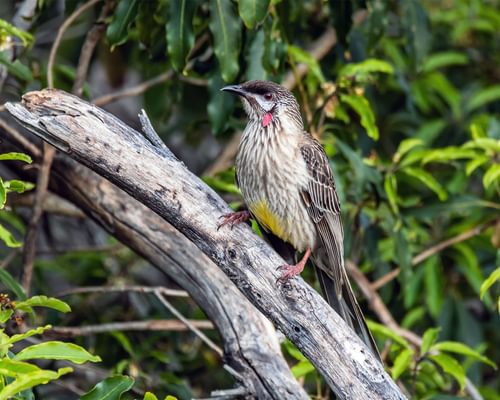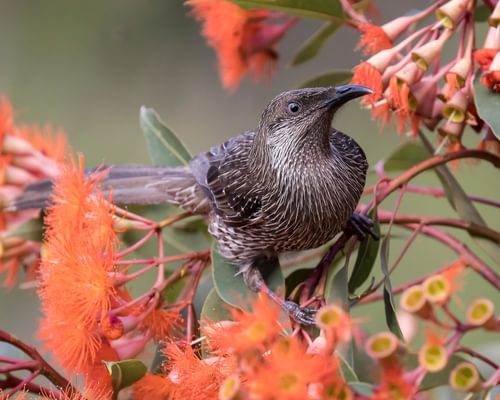Yellow Wattlebird
Least ConcernAnthochaera paradoxa
Visual Identification
Appearance
The Yellow Wattlebird is Australia's largest honeyeater, characterised by its distinctive yellow wattles hanging from the cheeks. Its plumage is predominantly grey-brown, with a streaked breast and yellow belly. The tail is long with white tips.
Males are larger than females and have more prominent wattles. Juveniles resemble adults but have smaller wattles and less distinct markings. Plumage remains consistent throughout the year.
Size
Length
37cm to 45cm
Wingspan
55cm to 65cm
Weight
150g to 200g
Colours
Males and females have similar plumage
Primary Colour
Yellow Brown Grey
Secondary Colour
White Black
Beak Colour
Black
Leg Colour
Grey
Habitat and Distribution
Habitats
Woodland
Garden
Wetland
Coastal
Urban
Farmland
Grassland
Desert
Tundra
Rainforest
Mountain
Savanna
Distribution
Yellow Wattlebirds are endemic to Australia, found primarily in Tasmania and parts of southeastern mainland Australia. They inhabit eucalyptus forests, woodlands, and coastal heathlands.
In urban areas, they frequent parks and gardens with native plants. Their distribution remains relatively stable throughout the year, with some local movements in response to flowering patterns of food plants.
Elevation Range
Sea level to 1,000 meters
Climate zones
Temperate
Distribution Map
This map gives you a rough idea of where you might spot a Yellow Wattlebird. The coloured areas show countries where these birds have been seen.
A few things to keep in mind:
- Birds might not be everywhere in the coloured areas, for example, they may be present around the coast of that country
- Where birds live can change with seasons and available food
- This map is quite simple - it doesn't show exact locations
We're working on making our maps even better! Soon, we hope to show you:
- More detailed maps for bigger countries, including state and region
- How birds move around during different seasons
Distribution by Region
Behaviour and Ecology
Bird Attributes
This feature is in beta. We'd love your feedback to improve it!
Share your thoughtsBird Attributes Explained
Our bird attributes system rates various aspects of a bird's capabilities on a scale of 0-100, based on data from field observations, scientific studies, and expert knowledge.
Attribute Categories:
- Agility: Manoeuvrability, speed, and grace in flight or movement.
- Strength: Physical power, often correlating with size and hunting abilities.
- Adaptability: Ability to thrive in various environments or changing conditions.
- Aggressiveness: Territorial behaviour and assertiveness, particularly during breeding seasons.
- Endurance: Stamina, often seen in migration patterns or foraging behaviours.
Understanding the Ratings:
- 0-20: Very Low
- 21-40: Low
- 41-60: Average
- 61-80: High
- 81-100: Very High
Remember, these attributes are relative to other bird species and don't necessarily indicate superiority.
Hover over the icon next to each attribute for more information.
Tap the icon next to each attribute for more information.
Agility
Reflects the bird's manoeuvrability, speed, and grace in flight or movement.
The Yellow Wattlebird demonstrates impressive agility, moving deftly through trees and even capable of brief hovering whilst feeding. Their ability to hang upside down to reach flowers further showcases their nimbleness.
Strength
Indicates the bird's physical power, often correlating with size and hunting abilities.
As Australia's largest honeyeater, the Yellow Wattlebird possesses considerable strength for its family. This is evident in its ability to defend territories and chase away other birds, though it's not exceptionally strong compared to larger avian species.
Adaptability
Represents the bird's ability to thrive in various environments or changing conditions.
Yellow Wattlebirds show good adaptability, thriving in various habitats from sea level to 1,000 metres, including urban areas. Their ability to adjust to flowering patterns of food plants indicates flexibility, though they're primarily specialised for specific ecosystems.
Aggressiveness
Measures the bird's territorial behaviour and assertiveness, particularly during breeding seasons.
These birds are renowned for their aggressive territorial behaviour, frequently chasing away other birds from feeding areas. Their loud, harsh calls and elaborate displays during breeding season further underscore their confrontational nature.
Endurance
Reflects the bird's stamina, often seen in migration patterns or foraging behaviours.
Yellow Wattlebirds exhibit strong endurance, evident in their ability to defend large territories and perform energetic courtship displays. Their size and varied diet likely contribute to good stamina, though specific long-distance flight capabilities are not noted.
Diet
Yellow Wattlebirds primarily feed on nectar from eucalyptus and banksia flowers. They supplement their diet with insects, particularly during breeding season.
These birds use their brush-tipped tongues to extract nectar efficiently and can often be seen hanging upside down to reach flowers.
Behaviour
Yellow Wattlebirds are known for their aggressive territorial behaviour, often chasing away other birds from feeding areas. They move through trees with agility, hopping along branches and probing flowers for nectar.
During the breeding season, males perform elaborate courtship displays, puffing out their wattles and producing loud calls.
Vocalisation
Yellow Wattlebirds are known for their loud, harsh calls. Their repertoire includes a distinctive 'yak-yak-yak' sound and a coughing 'cooack' noise.
During the breeding season, males produce a series of guttural notes that sound like 'kock-kock-kock', often accompanied by wing-flapping displays.
Nesting & Breeding
Breeding occurs from August to December, with pairs forming strong bonds. Males establish and defend territories, using loud calls and displays to attract females.
Nests are large, cup-shaped structures made of twigs, bark, and grass, typically placed high in tree forks. Females lay 2-3 pale pink eggs with reddish-brown spots.
Incubation lasts about 16 days, primarily by the female. Both parents feed the chicks, which fledge after approximately 20 days but remain dependent on adults for several weeks.
Lifespan
The Yellow Wattlebird typically lives for 7 to 8 years, with a maximum recorded lifespan of 9.8 years.
Like all birds, lifespan can be affected by factors including predation, habitat quality, disease, and access to food sources.
Conservation and Status
Global Conservation Status
While the Yellow Wattlebird is currently listed as Least Concern, it faces localised threats from habitat loss due to urban development and agriculture.
Conservation efforts focus on preserving native woodland habitats and maintaining urban green spaces with native flowering plants.
Population Data
Global Population Estimate
Not quantified, but common through its range
Birdwatching Tips
- Look for Yellow Wattlebirds in flowering eucalyptus trees
- Listen for their distinctive harsh, coughing call
- Observe their aggressive behaviour towards other birds
- Visit parks and gardens in Tasmania and southeastern Australia
- Use binoculars to spot their yellow wattles, which are key for identification
Additional Information
Quick Facts
Other names:
Wattled Honeyeater
Family:
MeliphagidaePredators
Main predators include large birds of prey such as Wedge-tailed Eagles and Peregrine Falcons, as well as introduced mammals like cats and foxes.
Did You Know?
- Yellow Wattlebirds are the largest honeyeaters in Australia.
- Their wattles can change colour slightly when the bird is excited or stressed.
- Despite their size, they are agile flyers capable of hovering briefly while feeding.
Was this bird profile helpful?
Your feedback helps us improve our content
Thanks for your feedback!
Your input helps us improve our content.
Community Experience
Community Ratings
No ratings yet - be the first to rate this bird!
Latest Community Reviews
No reviews yet
Sign in to be the first to review
Community Reviews
Create Your Free Account Welcome Back!
Join our community to rate birds and share your experiences. Creating an account is completely free and only takes a minute. Sign in to your account to rate birds and share your experiences with our community.
Your information is secure and will never be shared.
By creating an account, you agree to our Privacy Policy.
Similar Birds
References
- 2
website: BirdLife International. 2016. Anthochaera paradoxa. The IUCN Red List of Threatened Species 2016: e.T22704469A93970065.
View source - 3
report, 2001: Higgins et al.
- 1
website: ABBBS - Australian Bird and Bat Banding Scheme
View source

